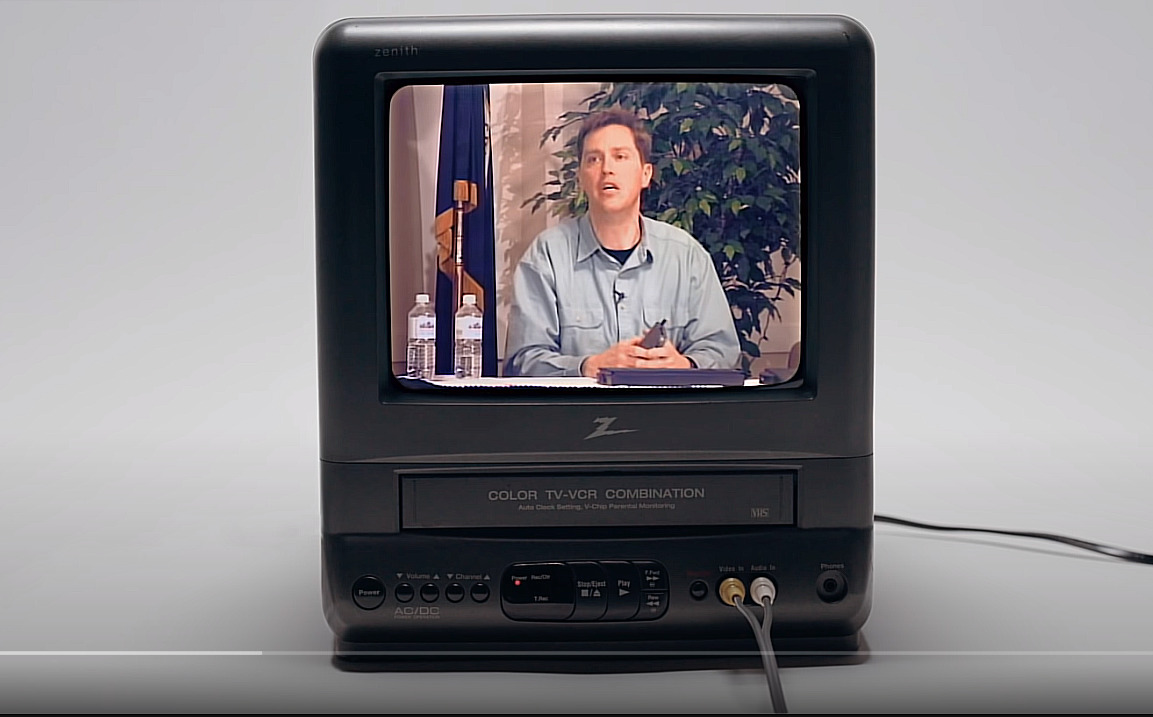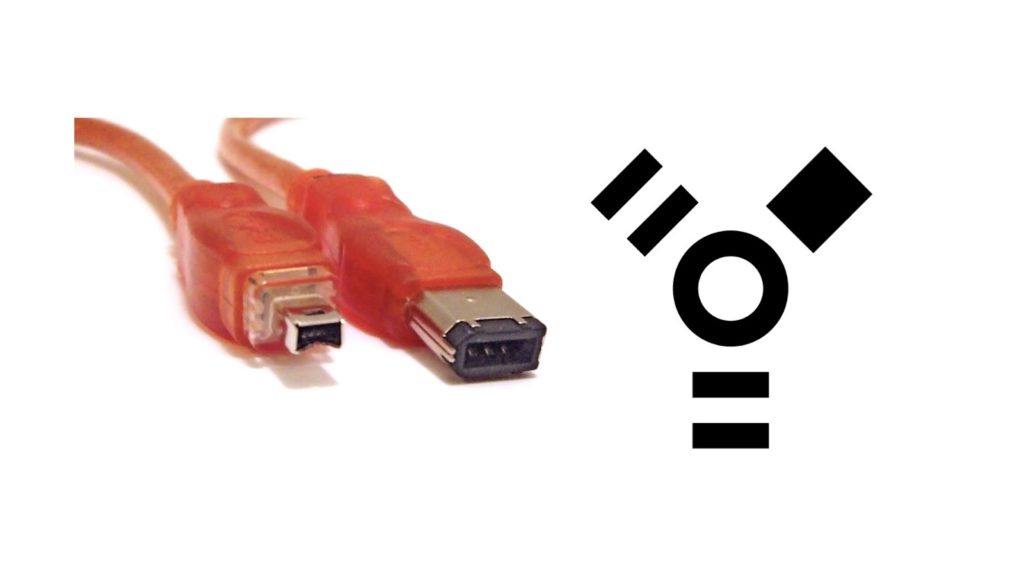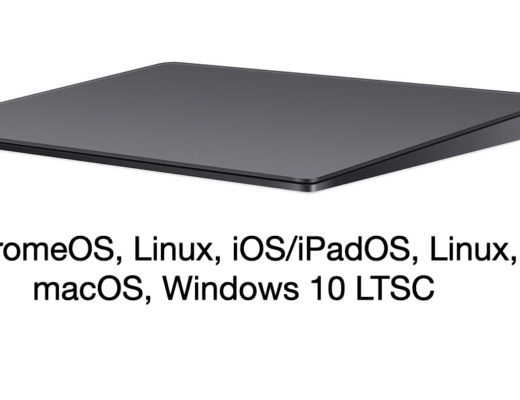
Here is my review on the unique Canopus/Grass Valley ADVC110 analog to digital converter with a built-in micro-TBC to capture old analog tapes to digital. This device is rather rare, since it has DIP switches for selecting PAL, SECAM, Japanese NTSC or NTSC with 7.5 IRE setup (pedestal) depending upon the source material each time, as well as a micro-TBC. For those unfamiliar, TBC stands for Time Base Corrector, which is an absolute must when capturing old VHS tapes, especially those shot with consumer camcorders. The TBC is also helpful for capturing other types of analog tapes, including U-Matic and any type of analog 8mm, Betamax or U-Matic. Ahead, I’ll distinguish between a traditional TBC and a micro-TBC and also explain the benefits of having this function built-into the A-to-D (analog-to-digital) device, rather than using a traditional standalone Time Base Corrector. I’ll also go over why it makes sense (for this type of material) to capture using the particular intermediate códec it uses, which is the same one used by Panasonic’s broadcast-quality DVCPRO and Sony’s broadcast DVCAM. Of course, I am talking about broadcast-quality digital formats used in the SD (standard definition) age, before HD (high definition). The goal of the ADVC110 is to capture from analog tapes which were recorded either in PAL, SECAM, Japanese NTSC (including many consumer camcorders sold in the Americas) with zero IRE standard black level (without pedestal) and US-NTSC with 7.5 IRE setup.
Scope of this article
Although ADVCHD110 is both an ADC (analog-to-digital converter) and a DAC (digital-to-analog converter), this article only covers its ADC function, for the purpose of capturing old standard definition analog videotape to a digital file on a computer.
Comparing a traditional standalone TBC with a micro-TBC
| Traditional standalone TBC | micro-TBC inside the ADVC110 |
|
| Time base stabilization | Yes | Yes |
| Advanced vertical pulse output | In certain models | No |
| Either 3.58 MHz or 4.43 MHz feedback (both rounded numbers) to improve overall quality when used with certain U-Matic decks | In certain models | No |
| Y/C input to improve quality with color-under formats, where the C (Chroma) signal is output either at baseband (3.58 MHz or 4.43 MHz feedback, both rounded numbers) or the downconverted heterodyned one, i.e. 688 kHz in NTSC. | In some models | Yes |
| Genlock (external sync) | In most models | No |
| Proc Amp (processor amplifier) with physical knobs | Yes | No |
| Direct digital output (to avoid extra conversions during capture to digital) | SDI output in very rare models | Yes! |
The above comparison chart excludes the built-in TBCs in most Betacam SP and MII decks, and some BVU U-Matic decks, as well as a tiny number of S-VHS decks.
Always connect Y/C (S-Video) instead of composite video whenever possible
Even if you are going to transfer standard VHS tape, you are much better off to do it with an S-VHS player with Y/C (S-Video) connections, since even on standard VHS tape (and Betamax and U-Matic), the luminance is recorded separately from the color information on the tape. Each time they are combined and separated again, there is a loss of quality. Since the ADVC110 indeed has a Y/C (S-Video) input, it will give you the best quality transfer even from an original tape that is not S-VHS.
Many U-Matic decks were modified to include the standard Y/C (“S-Video”) output and there were outboard boxes that would accept and convert the downconverted frequency of the DUB output of U-Matic editing decks to the standard ≈3.58 MHz for NTSC or ≈4.43 MHz for PAL. You may be able to purchase one of those boxes or purchase a U-Matic deck which has already been modified for that output.
Why your capture device should support these standards: Japanese NTSC, US-NTSC, PAL and SECAM
Many reviews of capture devices (and many «professional» capture service companies) are sadly done by people who are unaware of the important difference between Japanese NTSC and US-NTSC. Even when they are aware of it, many mistakenly assume that any camcorder sold in the Americas uses US-NTSC. That is not true. Many analog consumer camcorders which were sold in the Americas use Japanese NTSC, but not all of them.
The difference is that Japanese NTSC has its analog standard black level at zero IRE, while analog US-NTSC has its standard black level at 7.5 IRE. It is vital to have that level established at the digitization stage to make the black level be at the proper standard digital black level in digital. Having it set incorrectly means that the black level can be too grayish or crushing the black level. Either is terrible. To be more specific, whichever standard black level used in the analog source must be properly mapped to digital level 16 (for 8-bit video códecs) or to digital level 64 (for 10-bit códecs).
We are always best served by matching the black level during conversion from analog to digital. Forget about trying to adjust it later, since the results would be horrible, due to lack of latitude. Very few analog NTSC videotapes are labeled to indicate the standard black level used on them. We must determine it as explained in the next section.
How to determine the black level using the waveform in popular editing apps
Current versions of Blackmagic Davinci Resolve, Apple Final Cut Pro and Adobe Premiere Pro CC all show the standard black level as zero on their respective waveform monitors. (Thanks to Jeff Taylor for confirming this in FCP, and to Diego Pocoví and Rubén Abruña for confirming this for me in the current version of Premiere Pro CC.) As a result (with NTSC footage and the ADVC110 set for NTSC), if any of the footage has any black portion, moving the DIP switch 5 on the ADVC110 to the appropriate setting should show that black portion of the scene very close to zero and details in the black area should be visible on the computer screen should include detail, i.e. not be crushed or grayish.
How to set the DIP switches on the ADCHD110 for the proper format
DIP switches are on the underside of the ADVCHD110.
- DIP switch 3 is for the audio sampling frequency. Always switch it to OFF for 48 kHz audio sampling frequency.
- DIP switch 4 is the audio mode. Always switch it to OFF for locked audio, i.e. audio locked to video.
- When DIP switch 6 is set for NTSC, DIP switch 5 is for the NTSC setup (pedestal) level. Set it to OFF if your original tape uses Japanese NTSC with zero IRE setup. Set it to ON for US-NTSC with 7.5 IRE setup. If you don’t know which your original tape uses, play the video and watch it on the waveform monitor so that the blackest black in a scene reads close to zero on the graticule. Also, look on the computer monitor to see that the blackest black is not grayish and that there is still detail in black objects, as described early. This setting is only for this NTSC setup level when DIP switch 6 is set to NTSC.
- When DIP switch 6 is set to PAL, then DIP switch 5 alternates between PAL-B (off) and SECAM (on). Note that even in France (where analog broadcast was SECAM), some VHS players output PAL-B on their video outputs. Also note that in Argentina (where analog broadcast was PAL-N), S-VHS players and professional VHS players output PAL-B, not PAL-N, so they indeed work with the ADVCHD110.
- DIP switch 6 is for NTSC (off)or PAL/SECAM (on).
Why the DV25 códec is the best and most practical one as an intermediate for VHS, S-VHS or U-Matic (SP) capture
The ADVC110 converts analog video (and audio) to the DV25 códec via hardware, before sending it out to your computer.
The material on these analog videotapes we need to capture (VHS, S-VHS, Hi8 analog, Betamax, U-Matic) is nearly always interlaced video at a rate of either 50i (50 fields per second) in the case of most PAL or SECAM recordings or 59.94i (59.94 fields per second) in the case of either type of NTSC. Although our goal for current and future use is to is to have this material transformed to be at either 50p (i.e. 50 progressive frames per second) from PAL or 59.94p (i.e. 59.94 progressive frames per second), without having hardware that can do this reliably and with high quality in a single step (and without introducing additional A-to-D and D-to-A conversions), our best approach is to capture to DV25 at the native interlaced rate, for later software conversion to 50p or 59.94p and possible upconversion to higher resolution, depending on the target, which I’ll cover in upcoming articles.
Despite a tendency among some people to make fun of the DV25 códec since it is most frequently either 4:2:0 for PAL or SECAM-derived footage or 4:1:1 for NTSC-derived footage, tests done by colleagues have proven that the alternative (to use a traditional TBC, which sadly forces extra A-to-D and D-to-A conversions and then capturing the same material to uncompressed 4:2:2 using Blackmagic hardware) has produced indistinguishable captures, given the original VHS, S-VHS, analog 8mm or U-Matic material.

We must remember that this same DV25 códec was used in Panasonic DVCPRO broadcast camcorders (also used by Ikegami and Philips) and Sony DVCAM broadcast camcorders (also used by Ikegami) after they had already said goodbye to analog videotape. At that time, the DV25 códec in these two formats was being sold as greatly superior to the analog videotapes used previously for ENG, i.e. MII and Betacam SP (which were already better quality than U-Matic, S-VHS or VHS). From that perspective, we should not frown upon the DV25 códec as an intermediate for VHS, S-VHS or U-Matic. Instead, we should embrace it together with the ADVC110.

We are not talking about creating new HD or 4K material with DV25: that’s not even possible. We are talking about using DV25 as the ideal intermediate códec before later deinterlacing (via software) and possible upscaling (via software) while eliminating head-switching, unless it is desired to preserve it for aesthetic reasons, as covered in more detail in my recent article: Capture from VHS to 59.94p or 50p: best practices & goals

Above is an example of historical 4:3 footage superimposed over a 4:3 TV set, with head-switching visible (not cropped or overscanned) for artistic reasons. Image courtesy of The Verge’s documentary Springboard: the secret history of the first real smartphone.
The DV25 códec used is not only quite appropriate as an intermediate códec for the source material in this usage, it is also relatively light. The DV25 códec is 25 megabits per second, i.e. 3.125 MB (megabytes) per second, 187.5 MB per minute or about 11.25 GB per hour. On the other hand, with NTSC at 59.94, ProRes 422 LT would be 25.29 GB per hour.
Capture without transcoding
Since the goal is to capture the DV25 códec without further transcoding (yet), I don’t recommend capturing this material from the ADVC110 using Apple’s QuickTime Player, since the QuickTime Player would only offer to transcode into two different possible códecs, not leave it in its native one.
Both Final Cut Pro and iMovie (free on all Macs) can indeed capture the footage from the ADVC110 natively in DV25 (which Apple calls «DV/DVCPRO NTSC» or «DV/DVCPRO PAL» when getting information either in the Finder or later with the QuickTime Player. To my knowledge, the current version of DaVinci Resolve and DaVinci Resolve Studio don’t allow capturing from FireWire at all, so it would make sense to capture this footage first using the free and included iMovie (or WinDV for Windows) and then import the captured files into DaVinci Resolve (Studio) if you plan to do the upcoming steps in DaVinci Resolve (Studio).
PRECAUTION: Even though I recommend the use of iMovie for capture in case you plan to do the upcoming steps with DaVinci Resolve (Studio), I do NOT recommend EDITING this material with iMovie since the latest versions of iMove are way too limited in terms of how to deal with 4:3 material. However, iMovie does a great job of just capturing this 4:3 material.
Where to find the native (non-transcoded) captured files made in iMovie:
Home directory > Movies > iMovie Library > (right click/control click) Show Package Contents > (project name: the default is My Movie) > Original Media
Within that Original Media folder, you will find the captured files, wrapped with a QuickTime wrapper and with a .mov extension, but without transcoding. It will have the native códec, resolution, aspect ratio, field rate etc.
Where to find the native (non-transcoded) captured files made in Final Cut Pro:
See this Apple article to find the native DV25 (non-transcoded) captured files made with Final Cut Pro. Use the pulldown menu at the top of the article to choose your particular version of FCP.
The results of the intermediate códec after capture
The intermediate will not look good when played on your LCD monitor, since the intermediate is interlaced and your LCD monitor is not. In the steps I’ll cover in upcoming articles, I’ll explain software conversion to progressive, i.e. either 50p or 59.94p to preserve all of the temporal resolution (movement) in the original file so it can look as good as possible on today’s modern progressive screens.
How do I connect the ADVC110 to a modern computer in 2024?
The ADVC110 uses an IEEE 1394 port (aka FireWire or i.LINK) which is no longer present in modern computers. However, fortunately, there are adapters from IEEE 1394 to Thunderbolt. Below are the two Apple adapters I used in my testing:
- Apple Thunderbolt to FireWire Adapter A1463 MD464LL/A (~U$19.99)
- Apple MMEL2AM/A Thunderbolt 3 USB-C to Thunderbolt 2 Adapter A1790 (~U$29.99)
(These Apple adaptors also work with Windows, without the need to install drivers.)
Apple Silicon M1 (at least) fully supports IEEE 1394 adapted to Thunderbolt even with macOS Sonoma for this purpose, which excludes Apple Core Audio. (I used macOS 12.7.1 in my testing.) See my recent article:

PSA: Firewire isn’t completely dead even with macOS Sonoma for more details.
Regarding Intel processors, the following information is provided in Scott Schramm’s wonderful video:
- Intel still supports IEEE 1394 up until generation 9 with no problem.
- Intel requires workarounds with generations 10 and 11 require workarounds to use IEEE 1394. (With generations 10 and 11, either use Thunderbolt 3 built in (not Thunderbolt 4) or add an external Thunderbolt 4 adapter and then use the adapters covered above.
- Intel completely killed IEEE 1394 support starting with generation 12.
- For more details regarding Intel workarounds for generations 10 and 11, see Scott Schramm’s wonderful video.
Powering an ADVC110
Although it is possible to power the ADVC110 externally, in many cases (including mine using the adapters mentioned above and a FireWire cable terminating with a 6-pin plug), the ADVC110 self-powered from the two host computers used: my Mac Mini M1 and Francisco Javier Arbolí’s MacBook Pro M1 Pro.

Note that the ADVC110’s 6-pin FireWire port is in the rear (on the far left). The 4-pin FireWire port in the front cannot accept bus power. Only the 6-pin can.
How to source an ADVC110
Considering that they are no longer available as new, I purchased mine via eBay for U$149. Since then, I have seen some offers at lower prices.
Conclusions
Despite scarcity of the device on the market, I consider the unique Canopus/Grass Valley ADVC110 analog to digital converter with a built-in micro-TBC to be the best available way to capture most old analog tapes to the ideal digital intermediate, which is the DV25 códec used in broadcast formats like DVCAM and DVCPRO. Those include most analog 8mm, VHS, S-VHS, Betamax and U-Matic tapes. Fortunately, the ADVC110 is prepared for PAL-B, SECAM, Japanese NTSC and US-NTSC. Please follow my instructions as to how to connect and adjust, as covered in the article, as well as Intel compatibility up to and including generation 9 with no problem and 10/11 with workarounds. In upcoming articles, I’ll cover software methods to deinterlace 50i to 50p or 59.94i to 59.94p, preserving temporal resolution (movement) while upscaling and optionally removing head-switching noise.
Lee este artículo en castellano
(Re-)Subscribe for upcoming articles, reviews, radio shows, books and seminars/webinars
Stand by for upcoming articles, reviews, books and courses by subscribing to my bulletins.
In English:
- Email bulletins, bulletins.AllanTepper.com
- In Telegram, t.me/TecnoTurBulletins
- Twitter (bilingual), AllanLTepper
En castellano:
- Boletines por correo electrónico, boletines.AllanTepper.com
- En Telegram, t.me/boletinesdeAllan
- Twitter (bilingüe), AllanLTepper
Most of my current books are at books.AllanTepper.com, and also visit AllanTepper.com and radio.AllanTepper.com.
FTC disclosure
No manufacturer is paying for this article review. Allan Tépper purchased the ADVC110 with his own funds. Some of the manufacturers listed above have contracted Tépper and/or TecnoTur LLC to carry out consulting and/or translations/localizations/transcreations. So far, none of the manufacturers listed above is/are sponsors of the TecnoTur, BeyondPodcasting, CapicúaFM or TuSaludSecreta programs, although they are welcome to do so, and some are, may be (or may have been) sponsors of ProVideo Coalition magazine. Some links to third parties listed in this article and/or on this web page may indirectly benefit TecnoTur LLC via affiliate programs. Allan Tépper’s opinions are his own. Allan Tépper is not liable for misuse or misunderstanding of information he shares.

Filmtools
Filmmakers go-to destination for pre-production, production & post production equipment!
Shop Now












